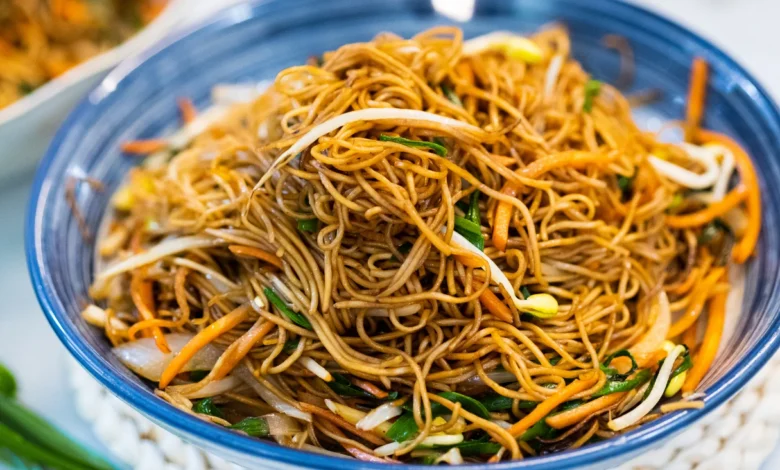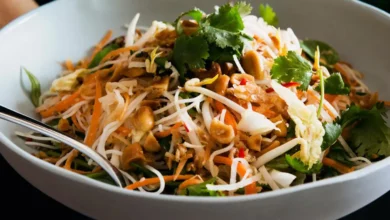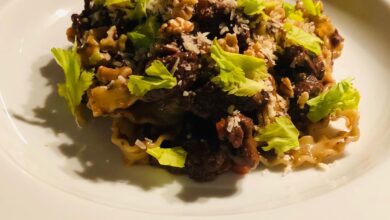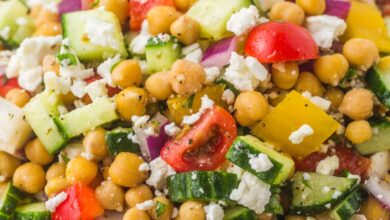
Chowmein Recipe
Introduction
Chowmein is a popular dish in Chinese and Indo-Chinese cuisine, consisting of stir-fried noodles, vegetables, and often meat or tofu. The dish originated in China but has been adapted to suit Indian taste buds by adding Indian spices and flavors.
Chowmein noodles can be made from a variety of ingredients, including wheat, rice, or egg, and can be found in different thicknesses and shapes. The vegetables used in chowmein can vary depending on personal preference, but commonly include cabbage, carrots, bell peppers, onions, and bean sprouts.
Chowmein is a versatile dish that can be served as a main course or a side dish. It is easy to prepare and can be customized to suit different dietary requirements, making it a popular choice among vegetarians and non-vegetarians alike.
In this recipe, we will be using wheat noodles, mixed vegetables, and chicken, but feel free to substitute any of the ingredients to your liking. Let’s get started!

Chowmein Recipe Brief explanation
Chow mein is a popular Chinese dish made with stir-fried noodles, vegetables, and sometimes meat. Here’s a brief explanation of how to make it:
Ingredients
- 8 oz chow mein noodles
- 1 tbsp vegetable oil
- 1 tbsp sesame oil
- 1/2 onion, sliced
- 2 cloves garlic, minced
- 1/2 bell pepper, sliced
- 1/2 cup shredded carrots
- 1 cup shredded cabbage
- 1/2 cup bean sprouts
- 1/4 cup soy sauce
- 1/4 cup oyster sauce
- 1 tsp sugar
- Salt and pepper to taste
Instructions
- Cook the chow mein noodles according to package instructions. Drain and set aside.
- Heat the vegetable oil and sesame oil in a wok or large skillet over high heat.
- Add the onion and garlic and stir-fry for 30 seconds.
- Add the bell pepper, shredded carrots, cabbage, and bean sprouts and stir-fry for 2-3 minutes, until the vegetables are slightly tender.
- Add the cooked chow mein noodles to the pan and stir-fry for an additional 2-3 minutes, until the noodles are heated through.
- In a small bowl, mix together the soy sauce, oyster sauce, and sugar.
- Pour the sauce over the chow mein and toss everything together until well coated.
- Add salt and pepper to taste, if needed.
- Serve hot and enjoy!
Chowmein Importance
Chowmein is a popular and beloved dish for several reasons, making it worth making at home. Here are some of the key reasons why chowmein is an important dish:
- Delicious and Flavorful: Chowmein is a dish that is packed with flavor and has a unique taste that is both savory and slightly sweet. The mix of different vegetables, spices, and noodles creates a delicious taste that is hard to resist.
- Versatile: Chowmein is a versatile dish that can be customized to suit different tastes and dietary needs. It can be made vegetarian or with different types of meat, and the vegetables used can vary depending on personal preference.
- Easy and Quick to Make: Chowmein is a quick and easy dish to make, making it a great option for busy weeknights or when you don’t have a lot of time to spend in the kitchen. With a few basic ingredients, you can have a delicious meal ready in no time.
- Affordable: Chowmein is an affordable dish that can be made with simple, inexpensive ingredients that are easy to find at most grocery stores.
- Healthy: Chowmein can be a healthy meal option, as it is packed with vegetables and lean protein. By using whole wheat noodles and limiting the amount of oil used in cooking, you can make it even healthier.
Overall, chowmein is a delicious and versatile dish that is easy to make and can be customized to suit different tastes and dietary needs. Whether you’re a fan of Chinese cuisine or simply looking for a quick and tasty meal option, chowmein is definitely worth making at home.
Chowmein tools needed
To make chow mein, you’ll need the following tools:
- Wok or large skillet: This is the primary cooking vessel that you’ll use to stir-fry the noodles and vegetables.
- Spatula: A spatula or wooden spoon is needed to toss and stir-fry the ingredients in the wok or skillet.
- Cutting board: You’ll need a cutting board to chop the vegetables.
- Knife: A sharp knife is needed to cut the vegetables and meat, if you’re adding it to the dish.
- Small bowl: You’ll need a small bowl to mix the sauce ingredients together.
- Colander or strainer: To drain the cooked noodles, you’ll need a colander or strainer.
- Measuring cups and spoons: You’ll need measuring cups and spoons to accurately measure the ingredients for the sauce.
- Plate or bowl: To serve the finished chow mein, you’ll need a plate or bowl.
Chowmein Step-by-step instructions
- Start by preparing the chowmein noodles according to the package instructions. Bring a large pot of water to a boil, add the noodles, and cook for 2-3 minutes or until tender. Drain the noodles and rinse them with cold water to prevent them from sticking together.
- Slice the boneless, skinless chicken breast into thin strips and season them with salt and pepper. Set aside.
- Prepare the mixed vegetables by slicing them thinly. You can use any combination of vegetables you like, but common choices include cabbage, carrots, bell peppers, onions, and bean sprouts.
- Mince the garlic cloves and set aside.
- In a small bowl, mix together the soy sauce, oyster sauce, and sugar. Set aside.
- Heat the vegetable oil in a large wok or skillet over high heat. Add the sliced chicken and cook for 3-4 minutes or until browned and cooked through. Remove the chicken from the pan and set it aside.
- Add the sliced mixed vegetables to the same pan and stir-fry for 2-3 minutes or until they are slightly softened. Add the minced garlic and stir-fry for another 30 seconds.
- Add the cooked chowmein noodles and the cooked chicken to the pan with the vegetables. Pour the sauce over the noodles and stir-fry everything together for 1-2 minutes, making sure the noodles are well-coated with the sauce.
- Serve hot and enjoy!
Chowmein special techniques or tips
- Use high heat: Stir-frying on high heat is key to achieving the signature smoky flavor and crispy texture of chow mein. Make sure your wok or skillet is hot before adding any ingredients.
- Prep all ingredients ahead of time: Once you start cooking, things move quickly, so make sure you have all the vegetables and meat sliced and ready to go before you turn on the stove.
- Cook the noodles al dente: Overcooked noodles can become mushy and clump together, so cook the noodles until they’re just al dente.
- Don’t overcrowd the pan: Overcrowding the wok or skillet can cause the ingredients to steam instead of stir-fry, so make sure there’s enough space in the pan to move the ingredients around.
- Add the sauce gradually: Don’t dump all the sauce into the pan at once. Add it gradually, tossing and stirring the ingredients to make sure everything is evenly coated.
- Customize to your liking: Chow mein is a versatile dish that can be customized to your taste preferences. Add more or less of any ingredient, or try different vegetables or proteins to make the dish your own.
- Add some crunch: For extra texture and crunch, consider adding some chopped peanuts or crispy fried noodles on top of the finished dish before serving.
Chowmein how to test for doneness
- Noodles: The noodles should be cooked through and tender but not mushy. You can test the noodles by tasting a strand or two to make sure they’re not undercooked or overcooked.
- Vegetables: The vegetables should be slightly softened but still crisp and vibrant in color. You can test the vegetables by tasting a piece or two to make sure they’re cooked to your liking.
- Chicken: The chicken should be cooked through and no longer pink in the middle. You can test the chicken by cutting into a piece to make sure there is no pinkness left.
- Sauce: The sauce should be well-distributed and evenly coat the noodles and vegetables. You can taste a small amount of the sauce to make sure it’s well-balanced and flavorful.
Chowmein Timing and temperature information
- Temperature: As mentioned earlier, it’s important to use high heat when stir-frying chow mein. The wok or skillet should be heated to about 400°F (200°C) before adding any ingredients.
- Cooking time: Cooking times can vary depending on the type and amount of ingredients you’re using. Here are some approximate cooking times for chow mein:
- Cooking the noodles: 4-5 minutes
- Stir-frying vegetables: 2-3 minutes
- Stir-frying noodles with vegetables: 2-3 minutes
- Adding the sauce and stir-frying everything together: 1-2 minutes
- Serving temperature: Chow mein is best served hot, right after cooking. If you need to keep it warm for a short time, you can cover the dish with aluminum foil or a lid to prevent it from cooling too quickly.
Keep in mind that the timing and temperature can vary based on your stove and other factors, so use your own judgment as you cook. With practice, you’ll become more comfortable and confident in making delicious chow mein!
Chowmein how to test for doneness
- Noodles: The noodles should be cooked through and tender but not mushy. You can test the noodles by tasting a strand or two to make sure they’re not undercooked or overcooked.
- Vegetables: The vegetables should be slightly softened but still crisp and vibrant in color. You can test the vegetables by tasting a piece or two to make sure they’re cooked to your liking.
- Chicken: The chicken should be cooked through and no longer pink in the middle. You can test the chicken by cutting into a piece to make sure there is no pinkness left.
- Sauce: The sauce should be well-distributed and evenly coat the noodles and vegetables. You can taste a small amount of the sauce to make sure it’s well-balanced and flavorful.
If everything is cooked to your liking and the sauce is well-distributed, your chowmein is ready to be served!
Chowmein Tips for presentation and garnishing
- Use a large serving platter: Chowmein is a dish that is meant to be shared, so it’s best to serve it on a large platter that can be easily passed around the table.
- Garnish with fresh herbs: Sprinkle some fresh chopped cilantro or scallions on top of the chowmein before serving. This adds a pop of color and fresh flavor to the dish.
- Add a squeeze of lime or lemon: A small squeeze of lime or lemon juice over the chowmein before serving can help brighten up the flavors and balance out the richness of the sauce.
- Serve with chili sauce: For those who like a little extra heat, serve chowmein with some chili sauce on the side. This allows guests to add spice to their own liking.
- Arrange vegetables and chicken on top: For an eye-catching presentation, arrange the cooked vegetables and chicken on top of the noodles on the serving platter. This creates a layered effect that looks beautiful and appetizing.
- Use a slotted spoon to serve: Chowmein can be a little messy to serve because of the noodles and sauce. Using a slotted spoon to serve the noodles and vegetables helps drain off any excess sauce and keeps the dish looking neat and tidy.
Chowmein Ideas for modify
Chowmein is a versatile dish that can be modified in many ways to suit your tastes or dietary needs. Here are some ideas for modifying chowmein:
- Vegetarian or Vegan: To make a vegetarian or vegan version of chowmein, simply omit the chicken and use vegetable broth or water instead of chicken broth. You can also add more vegetables like mushrooms, broccoli, and zucchini.
- Seafood: If you prefer seafood, you can substitute the chicken with shrimp, squid, or any other seafood of your choice.
- Spicy: For a spicy twist, add some red pepper flakes or chopped fresh chili peppers to the sauce. You can also serve the chowmein with extra chili sauce or hot sauce on the side.
- Peanut Butter: For a nutty flavor, add some peanut butter to the sauce. Start with 1-2 tablespoons and adjust to your liking.
- Curry: To give the chowmein an Indian twist, add some curry powder or garam masala to the sauce. You can also add some coconut milk for extra creaminess.
- Ramen: Instead of chowmein noodles, you can use ramen noodles for a different texture and flavor. Top the dish with a soft-boiled egg for a hearty meal.
- Teriyaki: To give the chowmein a sweet and savory flavor, use teriyaki sauce instead of soy sauce and oyster sauce. You can also add some sliced pineapple or bell peppers for extra sweetness.
Chowmein Summary and its key features
Chow mein is a popular Chinese dish that consists of stir-fried noodles, vegetables, and sometimes meat or seafood. Here are some key features of chow mein:
- Noodles: Chow mein is made with wheat-based noodles that are boiled and then stir-fried until crispy.
- Vegetables: A variety of vegetables are typically used in chow mein, such as cabbage, carrots, onions, and bean sprouts.
- Meat or seafood: Some versions of chow mein include meat or seafood, such as chicken, beef, shrimp, or squid.
- Sauce: Chow mein is often flavored with a savory sauce made from soy sauce, oyster sauce, and other seasonings.
- High heat: Stir-frying chow mein requires high heat to achieve the desired texture and flavor.
Chow mein is a versatile dish that can be customized to suit different tastes and dietary needs. It can be served as a main course or a side dish, and can be made vegetarian, vegan, or with added protein. With practice, you can master the art of making delicious chow mein at home.
Chowmein Final thoughts and suggestions for readers
howmein is a delicious and versatile dish that can be enjoyed in many ways. Whether you prefer it with chicken, vegetables, seafood, or a combination of different flavors, chowmein can be easily customized to your liking. With a few simple ingredients and some basic cooking techniques, you can create a restaurant-quality meal in your own kitchen.
Here are some final thoughts and suggestions for readers:
- Experiment with different ingredients: Chowmein is a great dish to experiment with. Try different vegetables, proteins, and sauces to create your own unique version of this classic dish.
- Don’t overcook the noodles: Overcooked noodles can turn mushy and ruin the texture of the dish. Be sure to cook the noodles according to the package instructions and taste them frequently to ensure they’re cooked to your liking.
- Use high heat: Chowmein is a stir-fry dish, so it’s important to cook it on high heat to get that nice seared flavor and texture.
- Prep all ingredients ahead of time: Chowmein comes together quickly once you start cooking, so it’s important to have all of your ingredients prepped and ready to go before you start cooking.
- Don’t be afraid to add more sauce: If you find that your chowmein is a bit dry, don’t be afraid to add more sauce. Just be sure to adjust the seasoning accordingly.
FAQs
What is chowmein?
Chowmein is a Chinese dish made with stir-fried noodles, vegetables, and meat or seafood. It’s typically seasoned with soy sauce, oyster sauce, and other seasonings.
What kind of noodles are used in chowmein?
Chowmein noodles are typically made with wheat flour and egg. They can be found in most Asian grocery stores and come in different thicknesses and shapes.
Can chowmein be made without meat?
Yes, chowmein can be made without meat. Vegetarian and vegan versions can be made by omitting the meat and using vegetable broth or water instead of chicken broth.
Can chowmein be made ahead of time?
Chowmein is best served fresh, but you can make it ahead of time and store it in the fridge for a few days. Just be sure to reheat it gently in a pan or in the microwave.
Can chowmein be frozen?
Yes, chowmein can be frozen for up to 3 months. Just be sure to let it cool completely before storing it in an airtight container or freezer bag.
Can chowmein be made with different sauces?
Yes, chowmein can be made with different sauces to create different flavors. Some popular options include teriyaki sauce, hoisin sauce, and curry sauce.
What vegetables can be used in chowmein?
Common vegetables used in chowmein include bell peppers, carrots, onions, cabbage, and bean sprouts. However, you can use any vegetables you like or have on hand.
Next Page





